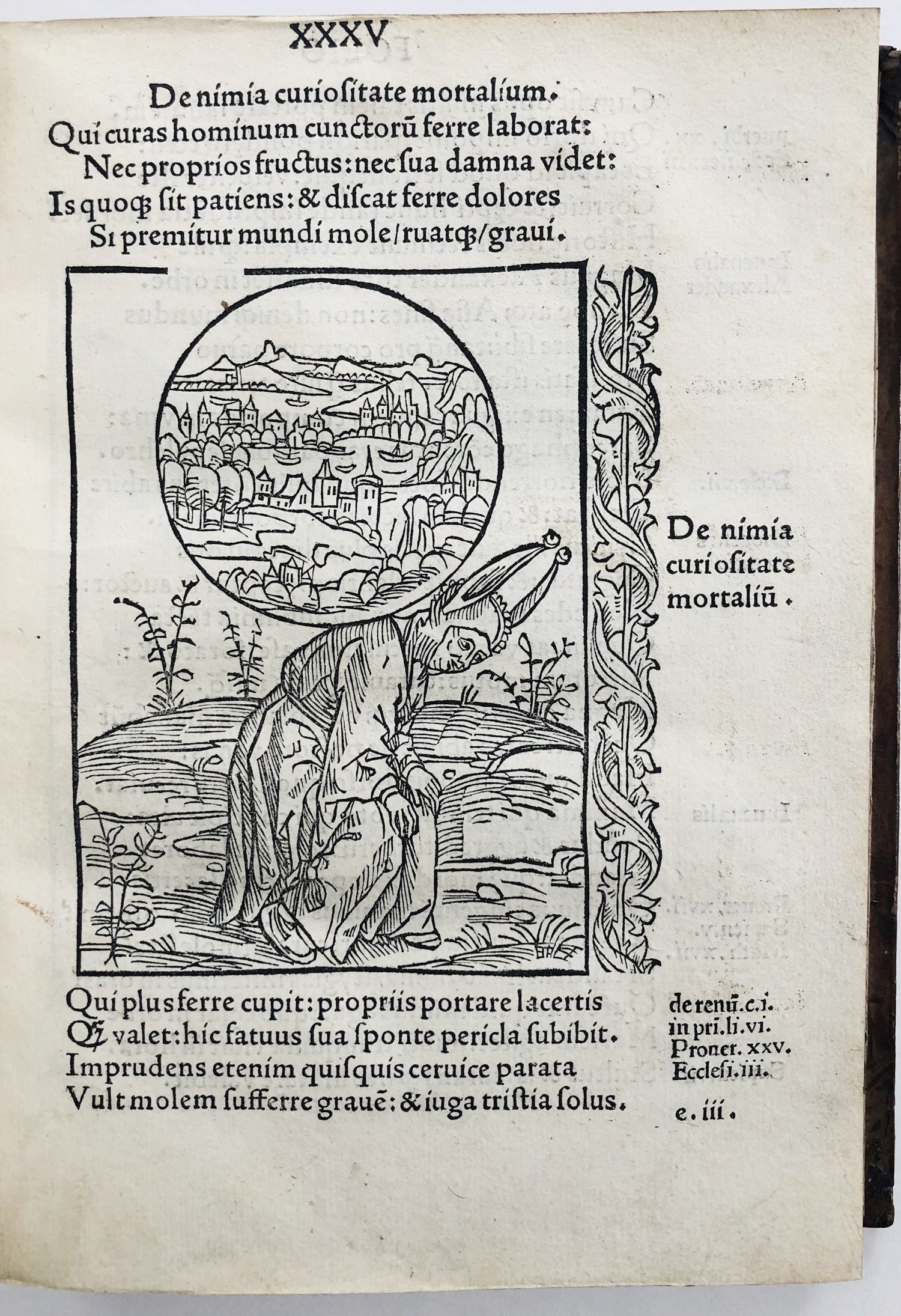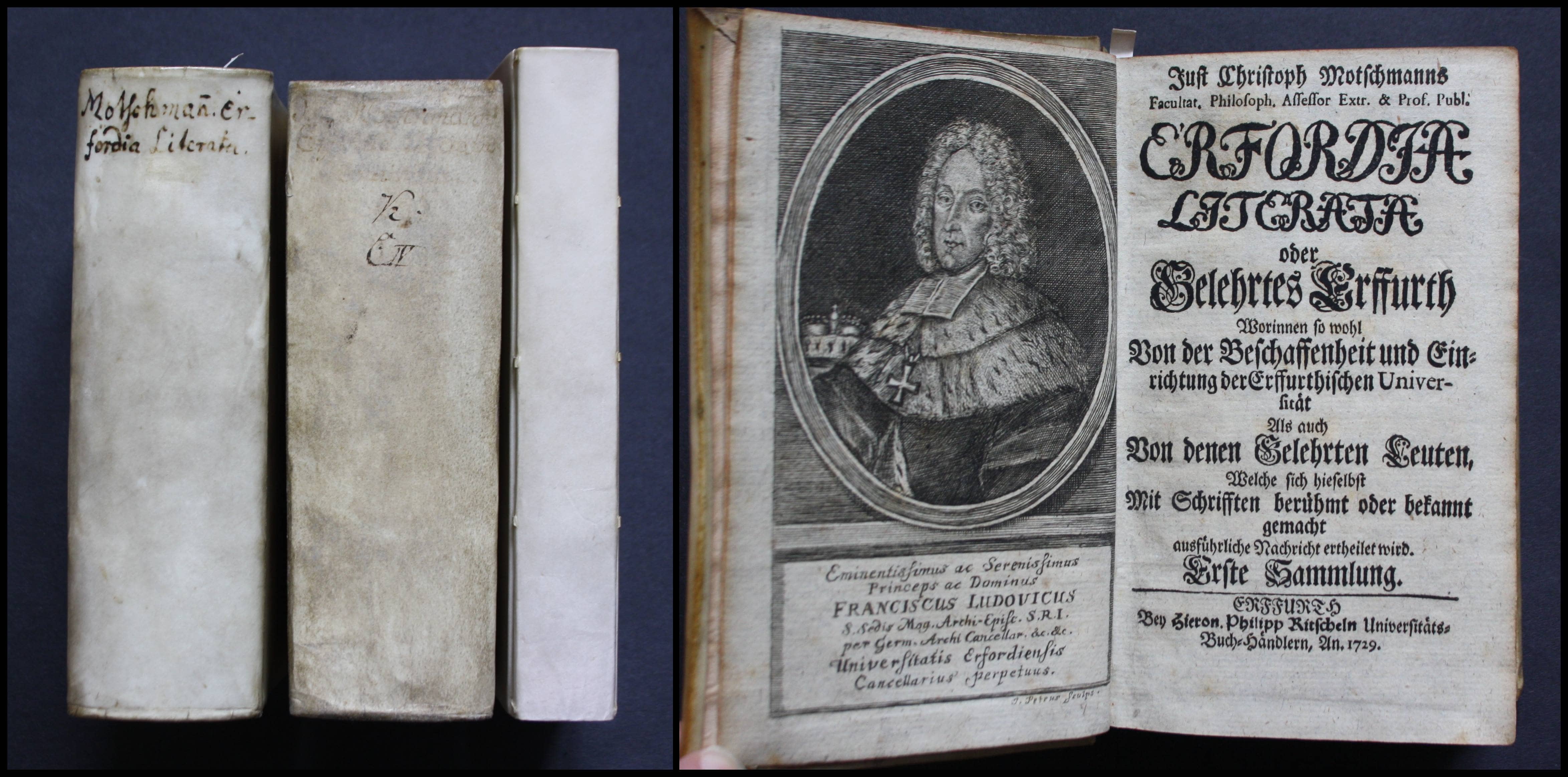Sebastian Brant / Jakob Locher – Stultifera Navis. Basel, Johann Bergmann von Olpe, 1st March 1497.
17th century calf. [21,4 x 16,4cm]. 145 numb. leaves, 3 unnumb. leaves. With 117 large woodcut illustrations by Albrecht Dürer and others.
FIRST LATIN EDITION.
Brant’s Ship of Fools became the most important of a long line of moralizing works in which the weaknesses and vices of mankind are satirized as follies. A satirical allegory in which more than 100 fools are on a ship’s journey to the fictional country of Naragonia, holding up a critical and satirical mirror to the world through an entertaining description of their vices and peculiarities. Composed in popular humorous verse and illustrated by a remarkable series of 117 woodcuts – of which seventy-five are now attributed to the young Albrecht Dürer – the book was an immediate success.
The Ship of Fools was the first original work by a German which passed into world literature and its influence was extensive and prolonged. Its most immediate imitators were Geiler von Kaisersberg, Thomas Murner, Hans Sachs and Johannes Fischart. Erasmus von Rotterdam’s Moriae Encomium was directly inspired by it.
Jacobus Locher’s important Latin translation is not a literal one, but rather a free adaptation (see: Michael Rupp. „Narrenschiff“ und „Stultifera navis“. Münster, Waxmann, 2002). It was this Locher version that quickly spread across national borders and made Brant’s Ship of Fools an international success, served as the basis for nearly all the fifteenth- and sixteenth-century reprints and translations.
Seventy-five of the woodcuts are attributed to the young Albrecht Dürer, the rest is ascribed to the master of the ‚Heintz Narr‘ (a provisional name deriving from the woodcut on f. 15 recto) and other local artists. (see: Friedrich Winkler: Dürer und die Illustrationen zum Narrenschiff. Berlin, 1951 and the Katalog zum Dürerjahr. München, 1971, N°. 154). They largely match those of the first and second German editions, three new woodcuts were engraved for this edition, the title illustration was re-engraved and the woodcut on ‚m1 verso‘ was also re-engraved, the decorative borders are only partially related. All woodcuts are in good impressions.
„The woodcut illustrations created for the Das Narrenschiff are of immense density and tenseness. Since there was no iconographical tradition for this newly conceived text, the subjects and scenes of the illustrations had to be created entirely new. The images presented are of such convincing force that their equal in design had never before been seen“ (A Heavenly Craft, p. 63). The Ship of Fools is the first literary work to announce the discovery of the New World, which is not surprising, since it was Bergmann who published the first German edition of the the Columbus letter, announcing his discovery of the New World, in 1493.
With some contemporary underlinings and marginalia. Slightly trimmed at the top, so that in some cases the pagination is somewhat cut off. A corner tear and a small tear in the white margin added, last leaf of the table laid down. Cover at front joint partly burst.
A very good copy.
Provenance: William Combes (1757?-1837) (His engraved bookplate on inner front cover)
Reference: GW 5054; Schreiber 3567; Hain 3746; Meder, Dürer S. 275; Schramm XXII, 32.
______________________________________________________________________________
ERSTE LATEINISCHE AUSGABE.
Brants Narrenschiff wurde zum wichtigsten einer langen Reihe von moralisierenden Werken, in denen die Schwächen und Laster der Menschheit als Torheiten persifliert werden. Eine satirische Allegorie, in der mehr als 100 Narren auf einer Schiffsreise in das fiktive Land Naragonien unterwegs sind und der Welt durch eine unterhaltsame Beschreibung ihrer Laster und Eigenarten einen kritisch-satirischen Spiegel vorhalten. Verfasst in populären humorvollen Versen und illustriert durch eine bemerkenswerte Serie von 117 Holzschnitten – von denen heute 75 dem jungen Albrecht Dürer zugeschrieben werden – war das Buch ein sofortiger Erfolg.
Das Narrenschiff war das erste Werk eines Deutschen, das in die Weltliteratur gelangte und dessen Wirkung weitreichend und nachhaltig war. Seine unmittelbarsten Nachahmer waren Geiler von Kaisersberg, Thomas Murner, Hans Sachs und Johannes Fischart. Erasmus von Rotterdams Moriae Encomium wurde direkt davon inspiriert.
Jacobus Lochers wichtige lateinische Übersetzung ist keine wörtliche, sondern vielmehr eine freie Bearbeitung des Textes (siehe: Michael Rupp. „Narrenschiff“ und „Stultifera navis“. Münster, Waxmann, 2002). Es war Lochers Version, welche sich schnell über nationale Grenzen hinweg verbreitete und Brants Narrenschiff zu einem internationalen Erfolg machte. Sie diente zudem als Grundlage für fast alle Nachdrucke und Übersetzungen des 15. und 16. Jahrhunderts.
75 der Holzschnitte werden dem jungen Albrecht Dürer zugeschrieben, der Rest wird dem Meister des „Heintz Narr“ (ein provisorischer Name, der sich aus dem Holzschnitt auf f. 15 recto ableitet) und anderen lokalen Künstlern zugeschrieben. (siehe: Friedrich Winkler: Dürer und die Illustrationen zum Narrenschiff. Berlin, 1951 und Katalog zum Dürerjahr. München, 1971, Nr. 154). Sie entsprechen weitgehend denen der ersten und zweiten deutschen Ausgabe, drei neue Holzschnitte wurden für diese Ausgabe angefertigt, die Titelillustration wurde neu geschnitten und der Holzschnitt auf ‚m1 verso‘ wurde ebenfalls neu geschnitten.
„The woodcut illustrations created for the Das Narrenschiff are of immense density and tenseness. Since there was no iconographical tradition for this newly conceived text, the subjects and scenes of the illustrations had to be created entirely new. The images presented are of such convincing force that their equal in design had never before been seen“ (A Heavenly Craft, p. 63). Das Narrenschiff ist das erste literarische Werk, das die Entdeckung der Neuen Welt ankündigt, was nicht verwunderlich ist, war es doch Bergmann, der 1493 die erste deutsche Ausgabe des Columbus-Briefes veröffentlichte, in dem er seine Entdeckung der Neuen Welt ankündigte.
Mit einigen zeitgenössischen Unterstreichungen und Marginalien. Oben leicht beschnitten, so dass die Paginierung stellenweise angeschnitten ist. Ein Eckeinriss und ein kleiner Einriss im weißen Rand ergänzt, letztes Blatt des Registers aufgezogen. Deckel am vorderen Gelenk teilweise geplatzt.
Sehr gutes Exemplar.
EUR 29.500,-




































